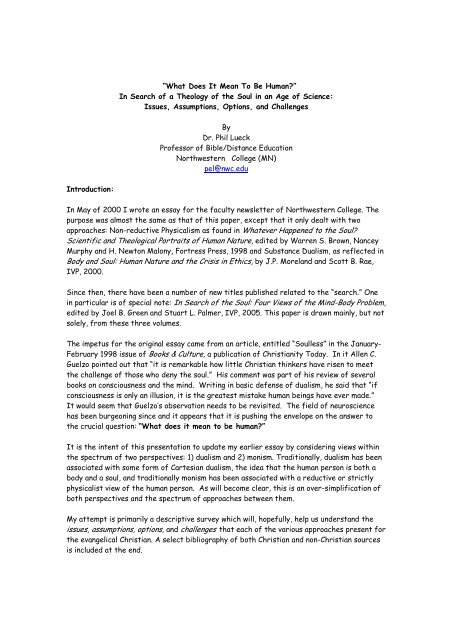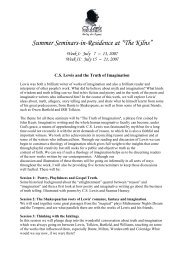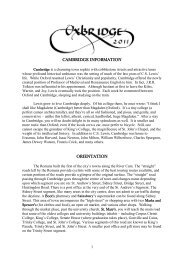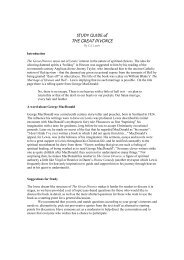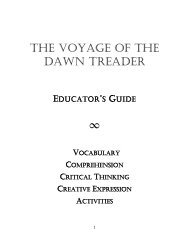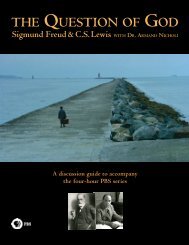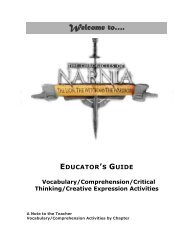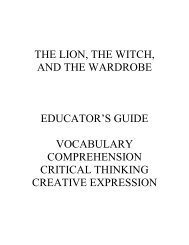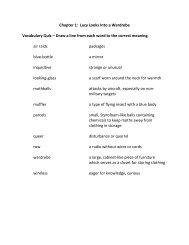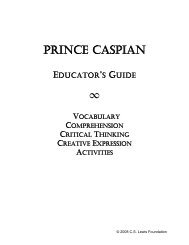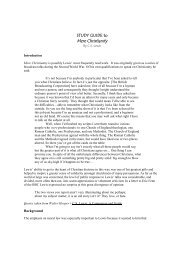What Does It Mean to be Human? - CS Lewis Foundation
What Does It Mean to be Human? - CS Lewis Foundation
What Does It Mean to be Human? - CS Lewis Foundation
- No tags were found...
Create successful ePaper yourself
Turn your PDF publications into a flip-book with our unique Google optimized e-Paper software.
“<strong>What</strong> <strong>Does</strong> <strong>It</strong> <strong>Mean</strong> To Be <strong>Human</strong>?”In Search of a Theology of the Soul in an Age of Science:Issues, Assumptions, Options, and ChallengesByDr. Phil LueckProfessor of Bible/Distance EducationNorthwestern College (MN)pel@nwc.eduIntroduction:In May of 2000 I wrote an essay for the faculty newsletter of Northwestern College. Thepurpose was almost the same as that of this paper, except that it only dealt with twoapproaches: Non-reductive Physicalism as found in <strong>What</strong>ever Happened <strong>to</strong> the Soul?Scientific and Theological Portraits of <strong>Human</strong> Nature, edited by Warren S. Brown, NanceyMurphy and H. New<strong>to</strong>n Malony, Fortress Press, 1998 and Substance Dualism, as reflected inBody and Soul: <strong>Human</strong> Nature and the Crisis in Ethics, by J.P. Moreland and Scott B. Rae,IVP, 2000.Since then, there have <strong>be</strong>en a num<strong>be</strong>r of new titles published related <strong>to</strong> the “search.” Onein particular is of special note: In Search of the Soul: Four Views of the Mind-Body Problem,edited by Joel B. Green and Stuart L. Palmer, IVP, 2005. This paper is drawn mainly, but notsolely, from these three volumes.The impetus for the original essay came from an article, entitled “Soulless” in the January-February 1998 issue of Books & Culture, a publication of Christianity Today. In it Allen C.Guelzo pointed out that “it is remarkable how little Christian thinkers have risen <strong>to</strong> meetthe challenge of those who deny the soul.” His comment was part of his review of severalbooks on consciousness and the mind. Writing in basic defense of dualism, he said that “ifconsciousness is only an illusion, it is the greatest mistake human <strong>be</strong>ings have ever made.”<strong>It</strong> would seem that Guelzo’s observation needs <strong>to</strong> <strong>be</strong> revisited. The field of neurosciencehas <strong>be</strong>en burgeoning since and it appears that it is pushing the envelope on the answer <strong>to</strong>the crucial question: “<strong>What</strong> does it mean <strong>to</strong> <strong>be</strong> human?”<strong>It</strong> is the intent of this presentation <strong>to</strong> update my earlier essay by considering views withinthe spectrum of two perspectives: 1) dualism and 2) monism. Traditionally, dualism has <strong>be</strong>enassociated with some form of Cartesian dualism, the idea that the human person is both abody and a soul, and traditionally monism has <strong>be</strong>en associated with a reductive or strictlyphysicalist view of the human person. As will <strong>be</strong>come clear, this is an over-simplification ofboth perspectives and the spectrum of approaches <strong>be</strong>tween them.My attempt is primarily a descriptive survey which will, hopefully, help us understand theissues, assumptions, options, and challenges that each of the various approaches present forthe evangelical Christian. A select bibliography of both Christian and non-Christian sourcesis included at the end.
2I. The Issues:Probably nothing in the known universe is as complex as human nature. For example, thehuman nervous system with its 100 billion neurons, each with an average of 3,000connections, means each human <strong>be</strong>ing has something like 100 trillion (10 14 ) synaptic switches!• Key issue:So, are we purely material/physical <strong>be</strong>ings? In other words should we considerourselves monistic? Or are we basically a material/physical body and a nonmaterialsoul/mind? In other words should we consider ourselves dualistic?Most, if not all, Christians have rejected monism. Many, if not all, Christians, andeven some <strong>be</strong>lievers of other faiths, hold (or at least assume) some form of a dualistanswer. His<strong>to</strong>rically, Christians have <strong>be</strong>lieved that some form of body-soul dualismis an essential part of orthodox Christian teaching. As far as the his<strong>to</strong>ricaldevelopment in biblical and theological studies is concerned, Nancey Murphy notesthat “it appears that the question of the metaphysical makeup of the human personhas not <strong>be</strong>en perceived, throughout the course of Christian his<strong>to</strong>ry, as a mattercentral <strong>to</strong> Christian teaching” (<strong>What</strong>ever Happened <strong>to</strong> the Soul? 19). While this may<strong>be</strong> true, most would agree that it is an important issue in the modern period due <strong>to</strong>the rise and development of biblical criticism and his<strong>to</strong>ricism as well as the placethat the concept of the soul has played in the his<strong>to</strong>ry of Christian ethics and theinterface <strong>be</strong>tween theology and science.For example, on the one hand, almost half of Body and Soul by Moreland and Rae(229-349) is taken up with matters related <strong>to</strong> how substance dualism affects theirapproach <strong>to</strong> abortion, fetal research, reproductive technologies, genetictechnologies, human cloning, euthanasia, physician-assisted suicide and the care ofpersons at the end of life. On the other hand, in <strong>What</strong>ever Happened <strong>to</strong> the Soul?there is only one chapter (“A Moral Case for Non-reductive Physicalism”), which hasexamples of Christian ethics in nonreductive physicalism, along with examples of theassumed moral achievements of substance dualism as well as the apparent adversemoral consequences of the view of nonmaterial souls.Today, many scientists and philosophers suppose that the person is but onesubstance – a material or physical body. Evolutionary biology and genetics bothsuggest our continuity with other life forms. The discipline of neuroscience has, forthis view, completed the “Darwinian Revolution,” bringing not only the human body,but the human soul/mind as well, in<strong>to</strong> the sphere of scientific investigation. Inparticular, nearly all of the human capacities or faculties, once attributed <strong>to</strong> thesoul/mind, are now seen <strong>to</strong> <strong>be</strong> functions of the brain.From this we can see that it is imperative that we answer our crucial question:“<strong>What</strong> does it mean <strong>to</strong> <strong>be</strong> human?”
3• Subsidiary issues:• Identity raises the question as <strong>to</strong> whether terms such as the soul and the mindare the same, whether the soul and the heart are the same, and whether themind and the heart are the same. They often appear <strong>to</strong> <strong>be</strong> interchangeable, inboth the Old and New Testaments.• Conceptual raises three questions. First, how does the concept of a nonmaterialsoul/mind/heart interface with a material/physical body? Second, how do theconcepts of consciousness or awareness relate <strong>to</strong> the biblical concepts ofsoul/mind/heart and the biblical concept of human <strong>be</strong>ings <strong>be</strong>ing made in the“image of God” and all this <strong>to</strong> the idea of human personhood? Third, are theconcepts of “<strong>be</strong>ing” and “person” the same? If so do they both have on<strong>to</strong>logicalstatus or is “person” just a functional term <strong>to</strong> descri<strong>be</strong> certain characteristics?• Theological raises the question about when things such as faulty braindevelopment, brain damage, brain disease or brain death could seem <strong>to</strong> causeimpairment or even dissolution of the person, how would these things affecttheir <strong>be</strong>ing a human “<strong>be</strong>ing” or “person?”All these subsidiary issues and their related questions must <strong>be</strong> addressed andanswered if we are <strong>to</strong> make any real progress in answering our crucial question:“<strong>What</strong> does it mean <strong>to</strong> <strong>be</strong> human?”II. The Assumptions:<strong>It</strong> is important <strong>to</strong> recognize how one’s assumptions, especially those which support one’sunderstanding of the science-theology interface, affect the way one will approach, not onlythe key issue, but the options. There are three basic models that deal with the sciencetheologyinterface reflected in the following three questions:• The Conflict Model asks: “Which comes first, science or theology? On the onehand, Christians tend <strong>to</strong> <strong>be</strong>lieve one must start with theology and then proceed <strong>to</strong>science, but only if science is in agreement with theology. On the other hand,scientists tend <strong>to</strong> <strong>be</strong>lieve one must start with science and then proceed <strong>to</strong> theology,but only if theology is in agreement with science. <strong>It</strong> is obvious that the “privileging”of either will sooner or later lead science and theology in<strong>to</strong> a conflict model. Forsome, both theology and science will never <strong>be</strong> able <strong>to</strong> avoid this seeming inevitabletension and conflict when truth claims are made from each. This has led <strong>to</strong> a secondmodel.• The Compartmentalized Model asks: “Why not allow science and theology <strong>to</strong> <strong>be</strong>sovereign, each in its own sphere?” This is achieved by separating science andtheology. <strong>It</strong> can <strong>be</strong> thought of as two parallel tracks that never come <strong>to</strong>gether.This reflects a compartmental model. <strong>It</strong> perpetuates the secular-sacred distinction.
4<strong>It</strong> operates on the presumed assumption that reality and truth are accessed eitherthrough the facts of science and/or through the faith of theology. Probably the<strong>be</strong>st known advocate of this approach is Stephen Jay Gould who, in his book Rocksof Ages: Science and Religion in the Fulness of Life, presents his argument for whathe called NOMA (for nonoverlapping magisteria). This certainly seems <strong>to</strong> “resolve”the possibility for potential and/or actual conflict <strong>be</strong>tween the two. However, itdicho<strong>to</strong>mizes or fragments the knowledge of reality and truth assumed in both.This is a very costly “peace” that denies both a truly full-or<strong>be</strong>d approach <strong>to</strong> doingboth science and theology. This leads <strong>to</strong> the third model.• The Complementary Model asks: “Is it possible for science and theology <strong>to</strong>complement one another?” Rather than creating the potential for conflict byseeking <strong>to</strong> privilege theology over science or science over theology orcompartmentalizing science and theology <strong>to</strong> avoid conflict, this model seeks <strong>to</strong> buildon the conviction that there is both an “authentic science” and an “authentictheology” and that efforts must <strong>be</strong> made <strong>to</strong> eliminate inputs from various kinds ofpseudo or counterfeit science and theology. This is the complementary model, whichallows each <strong>to</strong> contribute its own complementary answers <strong>to</strong> the questions withoutexpecting each <strong>to</strong> have the exact same answers.The complementary model does not <strong>to</strong>tally avoid the need <strong>to</strong> consider theassumptions, discussed above, about the relationship of science <strong>to</strong> theology whenconsidering the interface <strong>be</strong>tween the two. For the Christian who places biblicalauthority over scientific authority, one must minimally start with the evidence ofScripture. The crucial issue is whether scientific evidence, when considered, canthen trump the Scriptural/theological evidence. This is especially critical when thetheological evidence, based on Scripture, is presumed <strong>to</strong> <strong>be</strong> both relevant andsufficient <strong>to</strong> answer the scientific questions. In effect theology now trumpsscience.The complementary model functions <strong>be</strong>st when the assumption is accepted that bothscience and theology need each other <strong>to</strong> have a complete understanding of the issueunder study. His<strong>to</strong>rically, this has meant that some form of a “Double-Revela<strong>to</strong>ry”theory, which assumes that God has “Two Books of Revelation.” The first is the“Book of Nature (creation)” and theologically it is called “general revelation.” Thesecond is the “Book of Scripture (Bible)” and theologically is called “specialrevelation.” Obviously, there are times when the preponderance of evidence willseem <strong>to</strong> come more from one of the two.<strong>It</strong> should <strong>be</strong> noted that the issue of the appropriateness and degree it is forscience <strong>to</strong> give scientific answers <strong>to</strong> metaphysical questions and for theology <strong>to</strong> givetheological answers <strong>to</strong> scientific questions is at the very heart of the interface oftheology and science debate.
5III. The Options:With regard <strong>to</strong> our crucial question: “<strong>What</strong> does it mean <strong>to</strong> <strong>be</strong> human?” there have <strong>be</strong>enseveral classifications of ways <strong>to</strong> account for views of the nature of the person. I haveattempted <strong>to</strong> descri<strong>be</strong> the options through a two-category classification: dualism andmonism. <strong>It</strong> will <strong>be</strong> clear that there is some over-lapping <strong>be</strong>tween these two classifications.• Dualistic Views: There are at least four different forms of dualism.• Radical Dualism is where the soul (and/or mind) is <strong>to</strong>tally separable from thebody, and the human person is identified with the former. This is usually calledCartesian dualism <strong>be</strong>cause of its association with Rene Descartes. Sir JohnEccles of Oxford University is, perhaps, the <strong>be</strong>st contemporary proponent ofCartesian dualism.• Substance Dualism is the more traditional view of many evangelicals and theview of J. P. Moreland, professor of philosophy and Scott B. Rae, associateprofessor of biblical studies and Christian ethics, both at the Talbot School ofTheology, Biola University and authors of Body and Soul: <strong>Human</strong> Nature and theCrisis in Ethics. They prefer Thomas Aquinas’ philosophical-theologicalanthropology and call their version Thomistic substance dualism over againstCartesian substance dualism. Reformed philosopher John Cooper of CalvinSeminary, along with Roman Catholic apologists Peter Kreeft and Ron Tacelli, areamong noted contemporary Thomistic substance dualists.Substance dualism is also the view of Stewart Goetz, professor of philosophyand chair of the Department of Philosophy and Religion at Ursinus College andthe first contribu<strong>to</strong>r <strong>to</strong> the In Search of the Soul: Four Views volume. Hedefends his particular version by relying on the “powers of introspection” andwhat he calls the “Simple Argument.” The “power of introspection means that I,as an ordinary person can intuit (<strong>be</strong>lieve) that I am a soul that is distinct frommy physical (material) body. Hence I am what philosophers and theologians terma substance dualist, or more simply, a dualist” (33). Goetz’s Simple Argument fordualism can <strong>be</strong> summarized as following:• I am essentially simple• My body is essentially complex• If I am identical with my body, then whatever is a property of the one isa property of the other.• Therefore, <strong>be</strong>cause I have an essential property that my body lacks, Iam not identical with my body.• Emergent Dualism is the view of William Hasker, professor emeritus ofphilosophy at Hunting<strong>to</strong>n College and the second contribu<strong>to</strong>r <strong>to</strong> the In Search ofthe Soul: Four Views volume. He says that while he is “quite comfortable withmuch of what Goetz has written” he is “very suspicious of both sorts of claims
6<strong>to</strong> introspective awareness of one’s ‘true nature’ and the simplicity argument”(62).Hasker wants <strong>to</strong> take both the human soul and the human body seriously. On theone hand, Cartesian dualism has “<strong>to</strong>o wide a gap opened <strong>be</strong>tween the mind andthe body and <strong>be</strong>tween the mind and the world” (99). On the other hand, hecontends that “in order <strong>to</strong> close this gap, mind must somehow arise from thestructure and functioning of the biological organism, but is a substance in itsown right, not a mere system composed of the elementary particles ofmicrophysics” (100).• Holistic Dualism sees the person as composed of separable “parts” but is <strong>to</strong> <strong>be</strong>identified with the whole, whose normal functioning is as a unity. The human<strong>be</strong>ing, therefore, does not have a soul, but is a soul or human <strong>be</strong>ing. This appears<strong>to</strong> <strong>be</strong> the stress of the Hebrew grammar of Genesis 2:7 “and the man <strong>be</strong>came aliving <strong>be</strong>ing,” not “soul” as in the King James Version. This has <strong>be</strong>come theemphasis in much of recent evangelical theological anthropology. This viewusually assumes that “<strong>be</strong>ing” and “person” are interchangeable.• Monistic Views: There are at least three different forms of monism.• Reductive Physicalism is the view that a human person is purely a physicalorganism, whose emotional, moral, and religious experience will all ultimately <strong>be</strong>explained by the physical and biological sciences. This view is incompatible withhis<strong>to</strong>ric orthodox Christian teaching., but is the standard view of contemporaryneo-Darwinianism.• Nonreductive Physicalism is the view of Nancey Murphy, a professor ofChristian philosophy at Fuller Seminary, and the third contribu<strong>to</strong>r <strong>to</strong> the InSearch of the Soul: Four Views volume, where the person is a physical organism,whose complex functioning, both in society and in relation <strong>to</strong> God, gives rise <strong>to</strong>“higher” human capacities such as morality and spirituality.Murphy is clear in what she says nonreductive physicalism is not. First, shedenies that non-reductive physicalism is a denial of dualism. Second, she deniesthat the nonreductive part is a denial of the supposition that physicalism alsoentails the absence of human meaning, responsibility and freedom (115).However, she notes that <strong>be</strong>cause there is a wide variety of positions under theheading of nonreductive physicalism, as well as positions that are similar <strong>to</strong>nonreductive physicalism, but go by different names, it is therefore difficultfor her <strong>to</strong> give a positive account of her understanding of nonreductivephysicalism (115-116).Despite what she calls the “terminological tangles,” she seeks <strong>to</strong> sort throughthem and says: “For dualists, the concept of the soul serves the purpose ofexplaining what we might call humans’ higher capacities,” and concludes that in
7the nonreductive physicalist view “these higher capacities must <strong>be</strong> explained in adifferent manner. In part [italics hers] they are explainable as brain functions,but their full explanation requires attention <strong>to</strong> social relations, <strong>to</strong> culturalforces and, most importantly, <strong>to</strong> God’s action in our lives” (116).Murphy’s most recent exposition of her position is found in Bodies and Souls, OrSpirited Bodies? Cambridge University Press, 2006. The volume is part of theirCurrent Issues in Theology Series. In four chapters she asks and answers fourquestions: 1) Do Christians need souls? Theological and biblical perspectives onhuman nature, 2) <strong>What</strong> does science say about human nature? Physics,evolutionary biology, and neuroscience, 3) Did my neurons make me do it?Reductionism, morality, and the problem of free will, and 4) <strong>What</strong> are thephilosophical challenges <strong>to</strong> physicalism? <strong>Human</strong> distinctiveness, divine action,and personal identity.In the Preface (ix-x) she states that: “My central thesis is, first, that we arebodies – there is no additional metaphysical element such as the mind or soul orspirit. But, second, this ‘physicalist’ position need not deny that we areintelligent, moral, and spiritual <strong>be</strong>ings. We are, at our <strong>be</strong>st, complex physicalorganisms, imbued with a legacy of thousands of years of culture, and mostimportantly, blown by the Breath of God’s Spirit; we are Spirited bodies” (italicshers).• The Constitution View of Persons is the view of Kevin Corcoran, associateprofessor of philosophy at Calvin College and is the final contribu<strong>to</strong>r <strong>to</strong> thevolume In Search of the Soul: Four Views .The crucial issue for Corcoran is the distinctiveness of his view. He notes that”what many may find surprising about my view is that while I do not identifymyself with the immaterial soul or a compound of soul and body, neither do I<strong>be</strong>lieve that I am identical with the physical object that is my biological body.But how can that <strong>be</strong>? If I am neither an immaterial soul nor a compound of souland body, how could I possibly <strong>be</strong> a physical object if I am not the physicalobject that is my body? The view of human persons I defend is known in theliterature as the constitution view [italics his]. According <strong>to</strong> it, we humanpersons are constituted by our bodies without <strong>be</strong>ing identical with the bodiesthat constitute us” (156-157).Another crucial issue for this view (but not limited <strong>to</strong> it) is the problem ofnumerical sameness and qualitative sameness as relative <strong>to</strong> the nature of thepre-resurrection and post-resurrection body (169-172).A third, but perhaps more controversial, issue is the matter of “ethics at theedges of life.” These arise <strong>be</strong>cause “according <strong>to</strong> the constitution view of humanpersons, human persons are essentially physical and [italics his] essentiallypsychological. One implication of the constitution view is that no early term
8fetus constitutes a person. Another implication is that any entity oncepossessing, but having lost all capacity for, the relevant kinds of psychologicalstates also fails <strong>to</strong> constitute a person; and, therefore, some organisms in socalledpersistent vegetative states (PVS) no longer constitute persons” (.172).Corcoran’s position is more fully explained in his latest book: Rethinking <strong>Human</strong>Nature: A Christian Materialist Alternative <strong>to</strong> the Soul, BakerAcademic, 2006.I should acknowledge that there are those who have made attempts at provingthe existence of the soul/mind scientifically. One such is Kevin T. Favero’s TheScience of the Soul: Scientific Evidence of <strong>Human</strong> Souls, Edina, Minnesota:Beaver’s Pond Press, 2004). I have read the book and had extended discussionwith the author and I do not <strong>be</strong>lieve that Favero has given any real scientificevidence, but basically a rational argument for the human soul consistent withtraditional forms of substance dualism.IV. The Challenges:There are three main areas of challenge related <strong>to</strong> a search of a theology of the soul.• Methodological:<strong>It</strong> is not the intent of this paper <strong>to</strong> get in<strong>to</strong> the issues of on<strong>to</strong>logy (the study of thenature of <strong>be</strong>ing and reality) or epistemology (the study of knowledge and, especially,how we know what we know). As important as they are <strong>to</strong> our key issue, we will have<strong>to</strong> forgo them. We can summarize the methodological challenges by asking threequestions:oooFirst, what do we say about the role of science in “doing theology?” Doscientific descriptions really tell us the way things are, whereastheological descriptions are only subjective expressions of personalpreference? This is often the way in which scientists view theologicaldescriptions.Second, what do we say about the role of the Bible in ”doing science?”Do our interpretations of the Bible provide us with truly relevant andsufficient scientific descriptions as well as theological ones? This isoften the way theologians, especially conservative ones, view therelevancy and sufficiency of scientific descriptions drawn fromScripture.Third, how can we know reality and truth? On the one hand, is realitypurely physical? And if so, are scientific descriptions the only wayhuman <strong>be</strong>ings have <strong>to</strong> find out the truth about the world in which we liveand, most certainly, that would include what it means <strong>to</strong> <strong>be</strong> a human<strong>be</strong>ing? On the other hand, do theological descriptions give us the
9ultimate truth while scientific descriptions only give us incidental andrelatively unimportant details?• Theological:There are at least two crucial questions that face any of the dualist or monis<strong>to</strong>ptions that attempt <strong>to</strong> answer our crucial question: “<strong>What</strong> does it mean <strong>to</strong> <strong>be</strong>human?”• First, the question of the origin and transmission of the soul/mind ornonmaterial part of the human person has two possible views:oThe Creationist view (not <strong>to</strong> <strong>be</strong> confused with the creationistevolutionistdebate) has God creating each new soul/mind orperson and placing them in the body/brain at either conceptionor sometime <strong>be</strong>tween conception and birth. Many early churchfathers accepted this view that God created each individualsoul/person at the moment he gave it a body. Arguments cited infavor of creationism are:• Scripture distinguishes the origin of soul/person and body intexts like Eccl. 12:7; Isa.42:5; Zech. 12:1, and Heb. 12:9;• Creationism preserves the idea of the soul as a simple,indivisible substance <strong>be</strong>tter than traducianism;• Creationism makes more credible Christ’s retention of a puresoul than does traducianism.• Creationism is the official view of the Roman Catholic Churchand many in the Reformed tradition.oThe Traducian view has the soul/mind or nonmaterial part of thehuman person passed on or transmitted <strong>to</strong> the infant in the ac<strong>to</strong>f <strong>be</strong>ing procreated by the parents. Some early church fathers,like Tertullian, held <strong>to</strong> this view, that each soul/ person isderived, along with the body, from one’s parents. Argumentscited in favor of traducianism are:• Scripture supports it in texts like Gen. 2:2; Heb. 7:10; cf. ICor. 11:8);• <strong>It</strong> offers the <strong>be</strong>st theory for the whole race having sinned inAdam (cf. Rom 5: 12- 21);• <strong>It</strong> is supported by the analogy of lower life in whichnumerical increase is obtained by derivation;• <strong>It</strong> teaches that parents <strong>be</strong>get the whole child, body and soul,and not just the body,
10• <strong>It</strong> was necessary for Christ <strong>to</strong> have received his soul fromthe soul of Mary in order <strong>to</strong> redeem the human soul. MostProtestants hold <strong>to</strong> the traducian view.• Second, the question of the status of the person when the body dies hastwo views:oThe Soul Sleep view holds that the soul/person “sleeps” <strong>be</strong>tweendeath and resurrection. This doctrine or teaching has <strong>be</strong>en heldsporadically in the church. <strong>It</strong> is not a heresy in the narrowersense, but it may <strong>be</strong> called a doctrinal a<strong>be</strong>rration. The case forsoul sleep rests principally on the following assumptions:• <strong>Human</strong> existence demands the unity of soul/person and body.If the body ceases <strong>to</strong> function, so must the soul/person;• The use of the term “sleep” for death in Scripture isassumed <strong>to</strong> point <strong>to</strong> the cessation of consciousness;• A state of consciousness <strong>be</strong>tween death and resurrection,which would <strong>be</strong> characterized by either bliss or woe, wouldassumedly and unwarrantably anticipate the judgment of thelast day, when the basis for these experiences is determined.Martin Luther seemed sympathetic with a notion of soul sleepwith the parousia (second coming of Christ) as the awakening.oThe Intermediate State view, while holding that the normalhuman state is a union of soul/person and body, allows for thepossibility of a disembodied conscious existence <strong>be</strong>tween anindividual’s death and the final judgment and consummation. Thearguments cited for this view are:• <strong>It</strong> is held by both the analogy of God’s existence as purespirit (humankind <strong>be</strong>ing made in God’s image and on the basisof such passages as Heb. 12:23 and Rev. 6:9-11.• While there is no sustained reflection on the intermediatestate, some see a strong case in Paul’s discussion in II Cor.5:1-10. Here Paul seems <strong>to</strong> <strong>be</strong> struggling with his desire not<strong>to</strong> <strong>be</strong> “naked” (KJV) or “unclothed” (NIV). The understandingis that Paul did not want <strong>to</strong> experience “disembodiment,” i.e. aseparation of his soul/himself from his body after death.• II Cor. 5:8, is used <strong>to</strong> support the idea of an intermediatestate. However, some note that it is not explicit as <strong>to</strong>whether the <strong>be</strong>liever is consciously “awake” while “at homewith the Lord.” <strong>It</strong> is also pointed out that <strong>be</strong>cause theparousia was perceived as so real and imminent that it wouldhave seemed irrelevant <strong>to</strong> reflect on the state of the dead(cf. I Thess. 4:13-18).
11• Practical:Stuart L. Palmer, one of the two edi<strong>to</strong>rs of the In Search of the Soul: Four Viewsvolume and associate professor of pas<strong>to</strong>ral theology and psychology at AsburySeminary says, in the concluding chapter, that he hears on occasion: “But does thisreally have anything <strong>to</strong> do with the Christian life?” (189). He says “my concern is <strong>to</strong>translate how the four positions championed by our contribu<strong>to</strong>rs might relate <strong>to</strong>selected Christian practices and, conversely, how these practices might inform andassist in evaluating these four theories of human nature” (189-190). He dealsprimarily with the Christian practices of hospitality (194-205) and forgiveness (205-212) and concludes with some very insightful considerations of “From Practice <strong>to</strong>Theory” (212-215).These “challenges” may seem <strong>to</strong> have taken us afield from our search for a theologyof the soul and the key issue of what it means <strong>to</strong> <strong>be</strong> human. But it would seem that ifany view wishes <strong>to</strong> take both Scripture and science seriously, there are some keyquestions, within the spectrum of both the dualist and monist perspectives thatmust <strong>be</strong> wrestled with.For example, for dualists, who wish <strong>to</strong> stress that while we have a body, but we arenot just our body, and we need our body, there must <strong>be</strong> a way <strong>to</strong> explain how apresumably immaterial soul interfaces with a very apparent material body as well as<strong>to</strong> how an immaterial soul can <strong>be</strong> said <strong>to</strong> exist without its material body. This isespecially problematic, as I have noted, in the post-mortem <strong>be</strong>tween death and theresurrection.Also, for the monists, who wish <strong>to</strong> ground their perspectives in some form of aphysicalist view, there must <strong>be</strong> a way <strong>to</strong> account for the nature of those capacitiesthat are usually associated with an immaterial soul and how such emerges orsupervenes from the capacities of the faculties of the material body, and thequestion of what happens <strong>to</strong> those capacities when that body dies. This is especiallyproblematic if our self-identity or soulishness is embodied in a physical and mortalbody and raises the question of how can these survive death?Conclusion:Integrating and reconciling the truth claims made by Christian theology with new theories inscience, and especially neuroscience, is always challenging. If these two are viewed asmutually exclusive and incapable of <strong>be</strong>ing alternative or complementary explanations ofsimilar phenomena, the situation will seem irreconcilable. But even when viewed ascomplementary and potentially reconcilable, reams of description and discussion may often<strong>be</strong>come discordant <strong>be</strong>cause of the limits of our human faculties and our human penchant forhubris. So, in the midst of our quest for knowledge and truth, we must approach our taskwith a certain amount of humility and the recognition that we will never, this side of glory,know all knowledge and truth absolutely. I urge, however, the continued search for atheology of the soul in an age of science.
12A Select BibliographyPart I. Christian Perspectives:Ashbrook, James B. and Carol Rausch Albright. The <strong>Human</strong>izing Brain: Where Religion andNeuroscience Meet. The Pilgrim Press, 1997.Beck, James R. The Psychology of Paul: A Fresh Look at His Life and Teaching, KregelAcademic and Professional, 2002.Beck, James R. and Bruce Demarest. The <strong>Human</strong> Person in Theology and Pyschology,Kregel Academic and Professional, 2005.Boa, Kenneth. Augustine <strong>to</strong> Freud: <strong>What</strong> Theologians and Psychologists Tell Us About<strong>Human</strong> Nature [and Why <strong>It</strong> Matters]. Broadman and Holman Publishers, 2004.Brown, Warren S, Nancey Murphy, and H. New<strong>to</strong>n Malony (eds.) <strong>What</strong>ever Happened <strong>to</strong> theSoul?: Scientific and Theological Portraits of <strong>Human</strong> Nature. Part of the Theology andSciences Series. Fortress Press, 1998.Bruce, Barbara. Our Spiritual Brain: Integrating Brain Research and Faith Development.Abingdon Press, 2002.Brush, Nigel. The Limitations of Scientific Truth: Why Science Can’t Answer Life’sUltimate Questions, Kregel Academic and Professional, 2005.Chappell, Dorothy F. and E. David Cook (eds.) Not Just Science: Questions WhereChristian Faith and Natural Science Intersect, Zondervan, 2005.Clay<strong>to</strong>n, Philip. Mind and Emergence: From Quantum <strong>to</strong> Consciousness .Oxford, 2004.Collins, Gary R. The Magnificent Mind. Word Books, 1985.Colson, Charles W. and Nigel M. de S. Cameron, (eds.). <strong>Human</strong> Dignity in the BiotechCentury: A Christian Vision for Public Policy. IVP, 2004.Cooper, John W. Body, Soul & Life Everlasting: Biblical Anthropology and the Monism-Dualism Debate. Eerdmans, 2002 (Updated version).Corcoran, Kevin J. Rethinking <strong>Human</strong> Nature: A Christian Materialist Alternative <strong>to</strong> theSoul. BakerAcademic, 2006.Eccles, Sir John. Facing Reality: Philosophical Adventures by a Brain Scientist. Springer,1970. “Cartesian.”
13_____________ The Wonder of Being <strong>Human</strong>. Springer, 1984.Evans, C. Stephen. “Separate Souls: A Defense of ‘Minimalist Dualism,’ Southern Journalof Philosophy, Vol. XlX pp.313-331.Favero, Kevin T. The Science of the Soul: Scientific Evidence of <strong>Human</strong> Souls. Beaver’sPond Press,2004.Green, Joel B. (ed.). <strong>What</strong> About the Soul?: Neuroscience and Christian Anthropology.Abingdon Press, 2004.Green, Joel B. and Stuart L. Palmer (eds.). In Search of the Soul: Four Views of theMind-Body Problem. IVP, 2005.Gregersen, Niels Henrik, Willem B. Drees and Ulf Gorman (eds,) The <strong>Human</strong> Person inScience and Theology. Eerdmans, 2000.Hasker, William. The Emergent Self. Cornell University Press, 1999.Jeeves, Malcolm A. Mind Fields: Reflections on the Science of Mind and Brain. BakerBooks, 1994.______________ <strong>Human</strong> Nature at the Millennium: Reflections on the Integration ofPsychology and Christianity. Baker Books, 1997.______________(ed.). From Cells <strong>to</strong> Souls – and Beyond: Changing Portraits of <strong>Human</strong>Nature. Eerdmans, 2004.Jones, D. Gareth. Our Fragile Brains: A Christian Perspective on Brain Research.IVP,1981.Larsen, Jerry. Religious Education and the Brain: A Practical Resource forUnderstanding How We Learn about God. Paulist Press, 2000.Lints, Richard, Michael S. Hor<strong>to</strong>n and Mark R. Talbot (eds.) Personal Identity in TheologicalPerspective. Eerdmans, 2006.MacKay, Donald M. Brains, Machines, and Persons. Eerdmans, 1980.Machuga, Ric. In Defense of the Soul: <strong>What</strong> it <strong>Mean</strong>s <strong>to</strong> <strong>be</strong> <strong>Human</strong>. Brazos Press, 2002.Middle<strong>to</strong>n, J. Richard. The Li<strong>be</strong>rating Image: The Imago Dei in Genesis 1. Brazos Press,2005.Moreland, J.P. and David M. Ciocchi (eds.) Christian Perspectives on Being <strong>Human</strong>: A
14Multidisciplinary Approach <strong>to</strong> Integration. Baker Books, 1993.Moreland, J.P. & Scott B. Rae. Body and Soul: <strong>Human</strong> Nature & the Crisis in Ethics. IVP,2000.Morris, Tim and Don Petcher. Science and Grace: God’s Reign in the Natural Sciences,Crossway Books, 2006.Murphy, Nancey. Bodies and Souls, Spirited Bodies?. Cambridge University Press, 2006.Myers, David. The <strong>Human</strong> Puzzle: Pyschological Research and Christian Belief. Harperand Row, 1978.Peterson, Gregory R. Minding God: Theology and the Cognitive Sciences. Part of theTheology and Sciences Series. Fortress Press, 2003.Proc<strong>to</strong>r, James D.(ed.). Science, Religion,and the <strong>Human</strong> Experience. Oxford, 2005.Rollins, Wayne G. Soul and Psyche: The Bible in Psychological Perpective. Fortress Press,1999Swinburne, Richard. The Evolution of the Soul. Oxford, 1997 (Revised edition).Van Leeuwen, Mary Stewart. The Person in Psychology: A Contemporary ChristianAppraisal. Part of IFA<strong>CS</strong> – Studies in a Christian World View. IVP/Eerdmans,1985.Minimalist Dualism.Van Peursen, C.A. Body, Soul, Spirit: A Survey of the Body-Mind Problem. Oxford, 1966Part II. General Perspectives:Ackerman, Sandra J. Hard Science, Hard Choices: Facts, Ethics, and Policies GuidingBrain Science Today. Dana Press, 2006.This is part of The Dana <strong>Foundation</strong> Series onNeuroethics.Baars, Bernard, J. In the Theater of Consciousness: The Workspace of the Mind.Oxford University Press, 1997.Cairns-Smith, A.G. Evolving the Mind: On the Nature of Matter and the OriginConsciousness. Cambridge University Press, 1996.Chalmers, David J. The Conscious Mind: In Search of a Fundamental Theory. OxfordUniversity Press, 1996.Changeux, Jean-Pierre and Paul Ricoeur. <strong>What</strong> Makes Us Tick?: A Neuroscientist and aPhilosopher Argue about Ethics, <strong>Human</strong> Nature, and the Brain. Prince<strong>to</strong>n University
15Press, 2000.Churchland, Patricia Smith. Neurophilosophy: Towards a Unified Science of theMind/Brain. The MIT Press, 1998 (tenth edition).Crick, Francis, The As<strong>to</strong>nishing Hypothesis: The Scientific Search for the Soul. CharlesScribner’s Sons, 1994.Czerner, Thomas B. <strong>What</strong> Makes You Tick?: The Brain in Plain English. John Wiley andSons, 2001.Damasio, An<strong>to</strong>nio R. Descartes’ Error: Emotion, Reason, and the <strong>Human</strong> Brain. G. P.Putnam’s Sons, 1994.______________. The Feeling of <strong>What</strong> Happens: Body and Emotion in the Making ofConsciousness. Harcourt Brace, 1999.______________. Looking for Spinoza: Joy, Sorrow, and the Feeling Brain. Harcourt,Inc. 2003.Fisher, Len. Weighing the Soul: Scientific Discovery from the Brilliant <strong>to</strong> the Bizarre.Arcade Publishing, 2004.Flanagan, Owen. The Problem of the Soul: Two Visions of Mind and <strong>to</strong> Reconcile Them.Basic Books, 2002.Gazzaniga, Michael S. The Mind’s Past. University of California Press, 1998.Goldblum, Naolmi. The Brain-Shaped Mind: <strong>What</strong> the Brain Can Tell Us about the Mind.Cambridge University Press, 2001.Gregory, Richard L. The Oxford Companion <strong>to</strong> the Mind. Oxford University Press, 2004.Johns<strong>to</strong>n, Vic<strong>to</strong>r S. Why We Feel: The Science of <strong>Human</strong> Emotions. Perseus Books,1999.Kandel, Eric R. In Search of Memory: The Emergence of a New Science of the Mind,W.W. Nor<strong>to</strong>n, 2006.Koch, Chris<strong>to</strong>f. The Quest for Consciousness: A Neurobiological Approach. Ro<strong>be</strong>rts andCompany Publishers, 2004.McGinn, Colin. The Mysterious Flame: Conscious Minds in a Material World. Basic Books,1999.
16Nadeau, Ro<strong>be</strong>rt and Menas Kafa<strong>to</strong>s. The Non-Local Universe: The New Physics andMatters of the Mind. Oxford University Press, 1999New<strong>be</strong>rg, Andrew, Eugene D’Aquili and Vince Rause. Why God Won’t Go Away: BrainScience and the Biology of Belief. Ballintine Books, 2001.Penfield, Wilder G. The Mystery of the Mind. Prince<strong>to</strong>n University Press, 1975.Penrose, Roger. Shadows of the Mind: A Search for the Missing Science ofConsciousness. Oxford University Press, 1994.Rose, Steven. The Future of the Brain: The Promise and Perils of Tomorrow’sNeuroscience. Oxford University Press, 2005.Searle, John R. The Rediscovery of the Mind. The MIT Press, 1992.___________ Mind, Language and Society: Philosophy in the Real World. Basic Books,1998.Stapp, Henry P. Mind, Matter, and Quantum Mechanics. Springer-Verlag, 1993.Warner, Richard and Tadeusz Szubka (eds.). The Mind-Body Problem: A Guide <strong>to</strong> theCurrent Debate. Blackwell, 1994.Zeman, Adam. Conscousness: A User’s Guide. Yale University Press, 2002.


